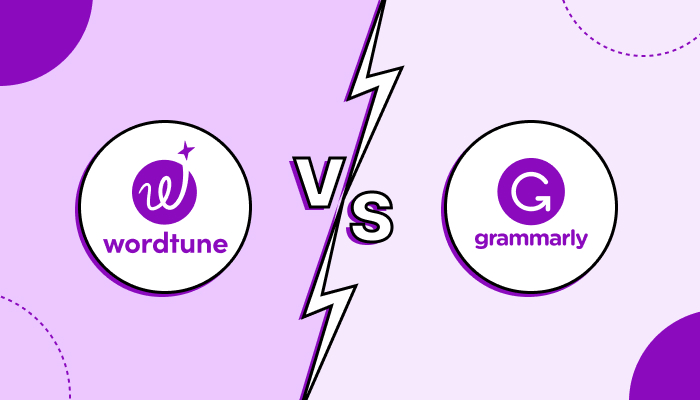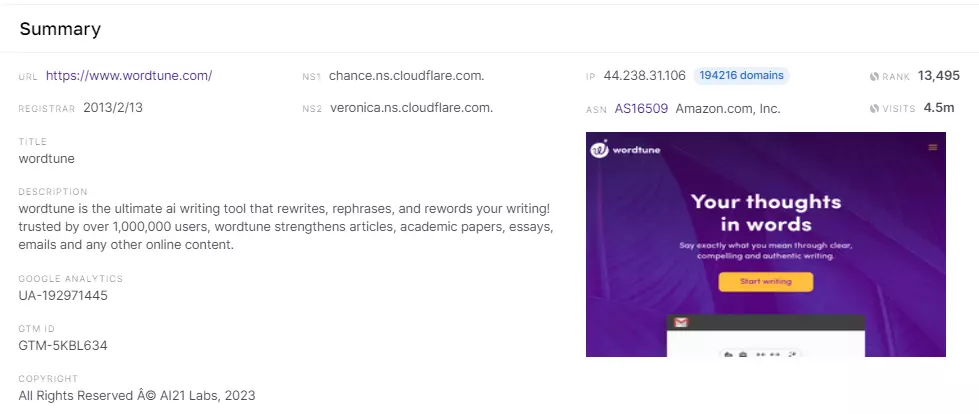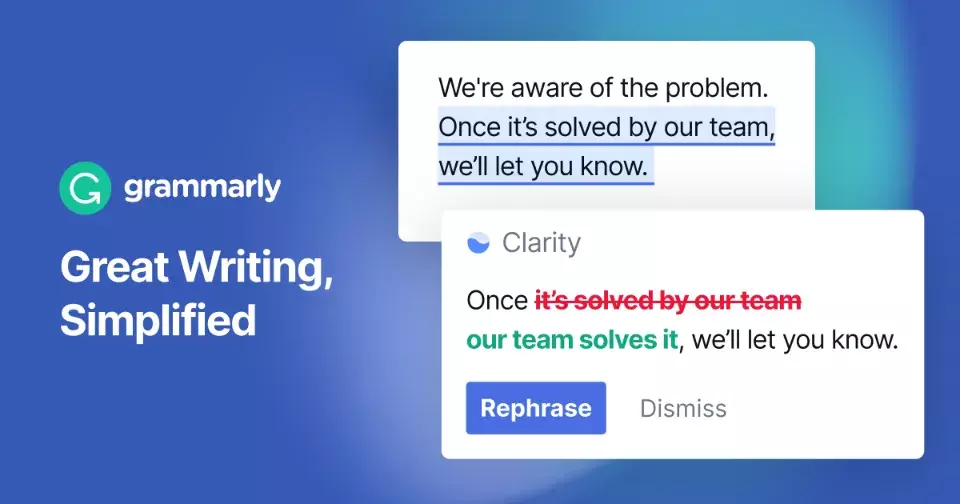
In the realm of AI-driven writing assistance, two titans stand out: Wordtune and Grammarly.
As writers, bloggers, and professionals continually seek tools to enhance their writing, a comparison between these two giants becomes crucial.
This blog will delve into the features, strengths, and weaknesses of Wordtune and Grammarly to help you make an informed decision on which tool aligns better with your writing needs.
What is Wordtune?
Wordtune is a generative AI tool designed to enhance your writing through AI-driven recommendations. Accessible on desktops, smartphones, and various applications, Wordtune empowers users to elevate their communication dynamically.
The tool's versatility comes to the forefront as it proves instrumental in refining diverse forms of writing, from social media posts and brainstorming sessions to technical writing and more.
Established in 2013, Wordtune can gain 4.5 million visitors every month.

Wordtune Key Features
1. Rewrites: Wordtune's rewriting feature is a standout, aiding users in rephrasing sentences in multiple ways. This not only helps in avoiding plagiarism but also imparts a professional touch to the writing.
2. Casual & Formal Tone: Offering a nuanced approach, Wordtune provides suggestions for both casual and formal tones. Users can seamlessly switch between the two styles by clicking on their desired tone, transforming the content to match the chosen style.
3. Summarizer: Wordtune goes beyond basic rewriting with its summarizer tool. Users can input text, links, or documents, and receive a concise summary of the most relevant points. This feature extends beyond text and even summarizes videos, converting them into succinct and value-packed passages.
4. Spices: A particularly intriguing feature, Spices, enhance writing with a variety of elements, including facts, humor, analogies, nature facts, inspirational quotes, examples, emphasis, numerical facts, and counterarguments.
5. Shorten & Expand: The shorten and expand feature allows users to modify sentence lengths, making them shorter or longer according to their preferences.
What is Grammarly?
Founded in 2009 by Max Lytvyn, Alex Shevchenko, and Dmytro Lider, Grammarly is an AI-powered writing tool that has become synonymous with producing error-free content.
It operates in real-time, checking writing as users type, eliminating the need for manual copy-pasting.

Grammarly extends its capabilities beyond grammar and spelling checks, delving into style suggestions. It identifies wordy sentences, incorrect comma usage, repetitive words, and other stylistic weaknesses.
Grammarly Key Features
1. Detailed Writing Suggestions: Grammarly provides advanced genre-specific suggestions, covering aspects such as word choice, formatting, conciseness, grammar, and spelling checks. It offers comprehensive insights to enhance overall writing quality.
2. Explanations: Acting as a sophisticated writing assistant, Grammarly not only polishes content but also provides detailed explanations and examples to illustrate errors and improvements.
3. Team Management: With its premium plan, Grammarly transforms its dashboard into a collaborative workspace, offering features like brand tone, snippets, style guides, and an analytical dashboard for team management.
4. Generative A-I Assistant (GrammarlyGo): Grammarly introduces a generative AI assistant named GrammarlyGo. This feature facilitates ideation, composition, personalization, rewriting, or quick responses to prompts within minutes.
5. Set Goals: Grammarly allows users to set specific goals for their writing, selecting the target audience from options like general, knowledgeable, and expert.
6. Personal Dictionary: The inclusion of a personal dictionary enables users to add commonly used terms or expressions to avoid constant corrections.
Wordtune Vs Grammarly Comparison
What are the differences between Wordtune and Grammarly?
1. Writing Assistance
Wordtune: Known for its real-time suggestions and contextual understanding, Wordtune excels in providing nuanced recommendations that align with the writer's voice and intent.
Grammarly: Renowned for its comprehensive grammar and spelling checks, Grammarly offers extensive writing insights and the added benefit of a built-in plagiarism checker.
2. User Interface
Wordtune: Boasts a user-friendly interface, ensuring ease of navigation for writers of all levels.
Grammarly: Features an intuitive design, providing a seamless writing experience across various platforms.
3. Language Support
Wordtune: Supports multiple languages, catering to a diverse user base.
Grammarly: Primarily operates in English, limiting its linguistic versatility compared to Wordtune.
4. Pricing
Wordtune: Offers both a free version with limited features and a subscription model for full access.
Grammarly: Follows a freemium model, with advanced features available through subscription plans.
Who Are They Best Suited For?
Wordtune: Ideal for those who value real-time suggestions and contextual understanding, especially in creative writing or varied linguistic contexts.
Grammarly: Suited for writers seeking comprehensive grammar and spelling checks, along with the added benefit of a plagiarism checker. It's particularly useful for English-focused content creators.
Conclusion on Wordtune Vs Grammarly
In the Wordtune vs. Grammarly showdown, both tools bring substantial strengths to the table. Wordtune excels in real-time suggestions and contextual understanding, making it a top choice for creative writers in diverse linguistic landscapes.
On the other hand, Grammarly shines in its comprehensive grammar checks, compatibility, and the inclusion of a plagiarism checker, catering to those who prioritize error-free writing and content originality.
Ultimately, the choice between Wordtune and Grammarly hinges on individual preferences, writing requirements, and the specific features that align with your goals.

